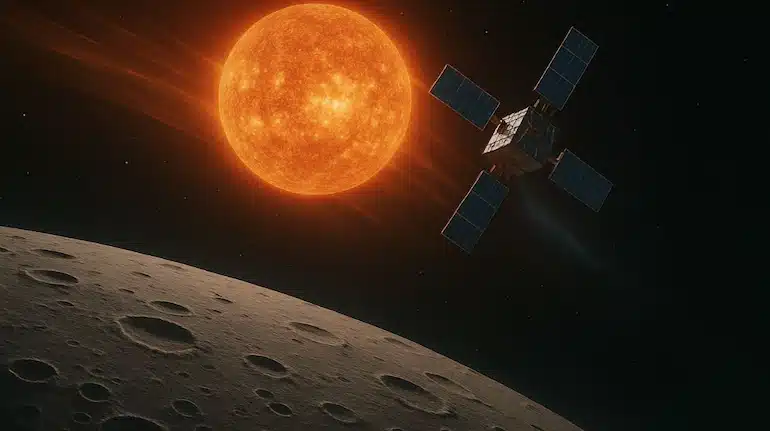Solar Wind Sparks Water Discovery on Moon

A groundbreaking study reveals that water on the Moon’s surface may originate from the solar wind, a finding that could have significant implications for future lunar exploration. Researchers found evidence of water and hydroxyl molecules in lunar regolith, with concentrations ranging from 200 to 300 parts per million. The low deuterium levels in these molecules suggest that their hydrogen is derived from solar particles, highlighting the potential for water resources on other celestial bodies as well.
NASA Confirms Solar Wind’s Role in Lunar Water Formation
For decades, scientists have speculated about the Sun’s contribution to the formation of water on the Moon. This theory, first proposed in the 1960s, posits that water molecules are generated through chemical reactions initiated by solar wind—streams of charged particles emitted by the Sun. Recent experiments led by NASA have validated this hypothesis through the most realistic laboratory simulations to date. The implications of this discovery are particularly relevant for NASA’s Artemis program, which aims to send astronauts to the Moon’s South Pole. Much of the lunar water is believed to be trapped in permanently shadowed regions, making it a crucial resource for future missions. Understanding the origins of this water could enhance the feasibility of sustained human presence on the Moon.
Mechanics of Water Creation on the Moon
The solar wind, primarily composed of protons—hydrogen nuclei stripped of their electrons—constantly flows from the Sun. While Earth’s magnetic field and atmosphere shield us from most of these particles, the Moon lacks such protection. When protons collide with the lunar surface, which consists of regolith, they interact with electrons, leading to the formation of hydrogen atoms. Recent findings indicate the presence of both hydroxyl and water molecules beneath the Moon’s surface. These molecules leave a distinctive chemical signature that can be detected through light interaction with the regolith. Currently, scientists categorize “water” as either hydroxyl or water molecules, as distinguishing between the two remains a challenge. NASA’s research team, including astronaut Yeo, analyzed samples from the Apollo missions using a specialized tool. This particle accelerator simulated solar wind conditions over several days, providing insights into how these processes occur on the Moon.
Broader Implications for Solar System Exploration
The discovery of water on the Moon raises exciting possibilities for other airless bodies in our solar system. If solar wind can create water on the Moon, similar processes may occur on other celestial objects, potentially expanding our understanding of where water exists beyond Earth. This could have profound implications for future space exploration and the search for extraterrestrial life. As scientists continue to explore the Moon’s resources, the findings from this study will play a vital role in shaping future missions and strategies for sustainable exploration. The presence of water not only supports human activities but also opens new avenues for scientific research and discovery in our quest to understand the universe.
Observer Voice is the one stop site for National, International news, Sports, Editor’s Choice, Art/culture contents, Quotes and much more. We also cover historical contents. Historical contents includes World History, Indian History, and what happened today. The website also covers Entertainment across the India and World.

